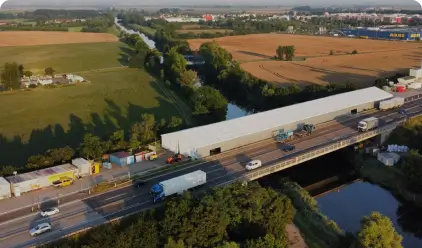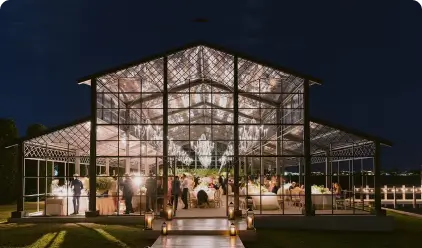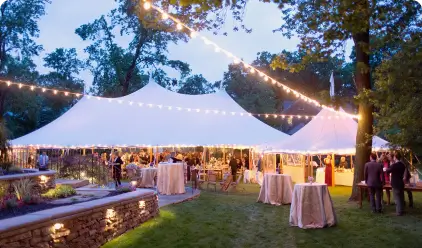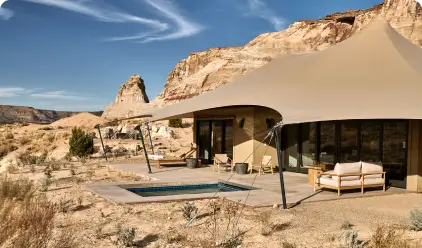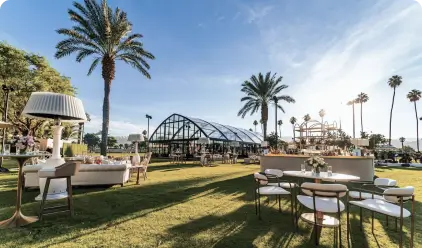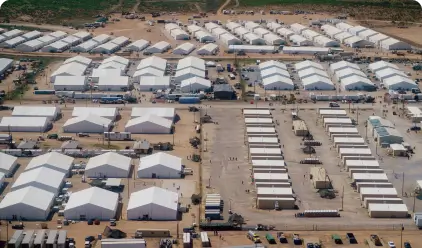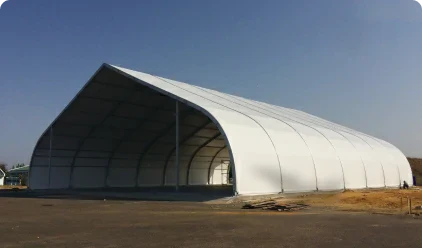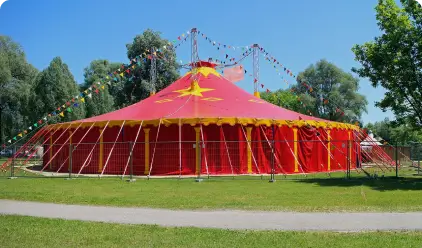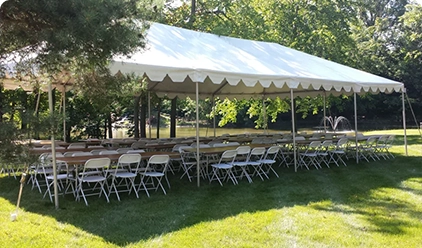Awning Vs Canopy: Which Is Better to Choose

Awnings and canopies are both popular additions to outdoor living spaces. They shield you from intense sunlight, UV rays, and rain, so you can comfortably enjoy your covered outdoor area.
However, the terms are often used interchangeably and lead to some confusion. Simply put, awnings are attached to buildings, while canopies are freestanding structures. Beyond this, awnings and canopies differ in many other ways.
In this article, we will detail the differences between awnings and canopies, including design, size, applications, flexibility, cost, etc. We will also provide practical advice to decide when you need to choose an awning vs canopy.
🎈You May Also Read:
How to Choose Between a Tent or Canopy for Camping and Events?
What's the Difference Among Gazebo and Canopy and Pergola?
Start with Design to Understand Awnings and Canopies
To choose between an awning and a canopy, it helps to first understand their designs and structures. Their structure determines how they function and where they are used. Let's begin by looking at each one in detail.
What Is An Awning?

An awning is a shade structure attached to the exterior wall of a building, typically fixed in place and unable to be removed. Some awnings are designed to be retractable, to roll up when not in use.
Usually, the frame of the awning is made of aluminum, iron, or steel, and the whole awning is composed of frame and fabric. Its main function is to block the sun and rain. It prevents a lot of sunlight from entering homes, to lower indoor temperatures. Simultaneously, they protect your flooring and furniture from sun damage.
Once installed, an awning becomes an integral part of the building, extending over windows, patios, or doorways. More than just functional, it adds decorative appeal to architecture.
When installed on the exterior wall of an office, the awning can block the sun without blocking the visibility inside the office. After installing an awning on the exterior wall of a restaurant, customers can dine or gather under the awning without worrying about sun damage or rain. Furthermore, some stores will also write the store name on the awning, so that it can serve as a billboard.
What Is A Canopy?

Compared to awnings attached to buildings, if you want to create shade outside a structure or residence, a portable temporary canopy is what you need. A canopy is a freestanding structure with a roof, typically a fabric covering over a metal frame. It can cover more areas than a typical awning, thus providing more protection.
Unlike awnings, canopies can be easily assembled, disassembled, and transported. This makes them preferred for temporary gatherings, markets, and outdoor events.
A canopy can also be a tent, generally with optional sidewalls, such as frame tent, high peak tent, etc. Such canopy tents can completely prevent rain from penetrating inside, and maintain a fully dry environment.
Design tells us a lot about how awnings and canopies function. But that's not the only thing that matters. How you plan to use your space, your budget, and many other factors influence the right decision.
Awning vs Canopy: Other Main Differences
Before we explore the other differences, take a moment to think about your outdoor space:
- Do you need shade for a fixed outdoor area like a patio, or frequently need to move equipment to different locations?
- Is your patio or outdoor space small, or is it large?
- How much time and effort are you willing to invest in installation?
- Is your budget adequate?
Your answers will help you understand the differences between awnings and canopies, as well as guide you in the right direction.
For a quick comparison, here's a table of awnings vs canopies.
| Factor | Awnings | Canopies | Better |
|---|---|---|---|
| Structural Design | Attached to a building’s exterior wall | Free-standing structure | \ |
| Application | Ideal for patios, balconies, windows | Best for outdoor gatherings, markets, events, and gardens | \ |
| Interior Influence |
|
Mainly affects outdoor comfort | Awnings |
| Space Saving Degree and Size |
|
|
\ |
| Installation | Requires professional mounting to the building | Easy to setup and take down | Canopies |
| Durability |
|
|
Canopies |
| Flexibility |
|
|
Canopies |
| Versatility |
|
|
Canopies |
| Cost | Generally higher than canopies | Relatively cheaper than awnings | Canopies |
Application
If you plan to add outdoor seating at your store or café, awnings are an excellent solution. Awnings are generally used to block the sun's rays without affecting sight or ventilation.
However, canopies offer far more versatile applications. At wedding events, sports events, exhibitions, promotions, and a variety of other activities, canopies provide protection from the sun and rain to ensure events run smoothly. Installing a canopy on a patio or garden can block heat and rain and enhance the beauty of an outdoor room.
Some canopies can also be used as carport roofs to protect cars from wind, precipitation, and snow.
Interior Influence
If you install an awning on your window, it will reduce the amount of sunlight entering the room, keeping it cooler.
In contrast, a canopy is designed to create a shaded oasis for backyards or any type of outdoor gathering. It can be equipped with side walls and fitted with air conditioning. An air-conditioned canopy transforms any hot outdoor area into a comfortable retreat.Space
Saving Degree and Size
The awning and canopy have very different degrees of space saving due to their different structures.
An awning is only fixed on the exterior wall of the building and does not occupy any space inside the building. On the outside, the awning is fixed and suspended and does not need to occupy any ground space.
In contrast, the canopy is a semi-enclosed space built with supports and fabrics. Whether it is in the yard or outdoors, it needs to occupy a certain amount of ground space.
Consider your available space when deciding between awnings and canopies. Size is another factor.
Since awnings attach to buildings, they cannot be too large, as this would compromise structural integrity. Typically, an awning extends only a few feet.

Canopies, however, offer greater space. With sufficient available area, a canopy can be designed to be spacious enough to accommodate your guests. Small canopies start at 100 square feet, while large ones can reach up to 4,000 square feet in total area.
Therefore, make an informed decision by comprehensively evaluating your intended use, required space, and available area.
Installation
The awning needs to be fixed to the exterior wall to provide a solid foundation to prevent it from collapsing, so the installation of the awning requires professional personnel. This may involve installing hardware, electrical connections, and other components.
Retractable awnings are particularly challenging to install due to their inclusion of motorized systems. Improper installation can compromise functionality or damage walls.
In contrast, canopies are easy to install, designed with prefabricated modular structures. When installing, simply connect the modular components one by one. There is no technical difficulty, even if you have never worked with tents before.

Durability
Canopies and awnings are both designed with durability and longevity in mind. However, canopies typically feature sturdier frames and heavier-duty weather-resistant fabrics, so they last longer.
Awnings, especially fixed structures, may wear out faster due to prolonged exposure to harsh weather like sunlight, rain, and snow accumulation. In contrast, canopies are more robust in construction and usually stored properly when not in use.
Flexibility
After installation, the Awning can only be fixed on the exterior wall. Even retractable awnings can only be rolled up when not in use, not removed entirely. If it is not damaged and needs to be replaced, it is generally not movable. Canopy is much more flexible. It can be installed when it is needed to provide shelter or space.
And when it is not needed, its simple structures allow for easy disassembly and storage. Moreover, the canopy can be adjusted at any time according to needs, and it can be easily moved to other locations.
In comparison, the flexibility of the canopy is better than that of the awning, as the awning can only be fixed in one place.
Cost
For the same coverage area, such as 12x12ft, the cost of the basic awning is $400 – $1,300, while the cost of the basic canopy is $200-$400. In this comparison, the cost of the canopy tent is cheaper.
And if you want to upgrade the function, such as upgrading the awning from manual to electric, the corresponding cost will become higher. The cost of the electric awning 12x12ft will be $1,900 – $3,300.
Awning vs Canopy: How to Choose?
Now that you understand the difference between awnings and canopies, you should have a clearer idea of how to make your choice. To help you decide more easily, here are three possible decisive factors.
Purpose of Use
If you want it to be fixed outside the window for a long time, provide continuous shading, and reduce air conditioning costs, there is no doubt that you should choose an awning.
But if you want to build a sunshade and rain shelter space in the yard occasionally, the canopy is more suitable for your needs. And canopy can be placed not only in the yard, but also for camping, hiking, and even on the beach.
Space Requirements
The awning does not take up any ground space. When space is limited, the awning can save space to the maximum extent. However, they can only shade a small area.
In contrast, the canopy requires a certain amount of ground space to build. Nevertheless, if you need a larger outdoor comfort space, a canopy fully meets your needs.
In summary, when choosing, prioritize whether the site can accommodate the installation and the size of space you require.
Budget
There are many different types of awning and canopy. Generally, the awning is more expensive than the canopy, and the awning needs to be installed by professionals, which will also increase your costs.
In addition, the awning is exposed to wind and sun for a long time, and it will break quickly, thus the replacement frequency is higher than that of the canopy.
Therefore, if you only need to build a sun-proof and rain-proof space occasionally, and don’t want to spend too much on high cost, a canopy would be a better choice.
In actual application, how to choose depends on your specific needs and personal preferences.
Interested in Installing a Canopy? Sheltent Here for You
Choosing between awning vs canopy isn't particularly difficult. It mainly comes down to what matters most to you and which option best suits your outdoor space. Keep in mind that if you're looking for a portable, versatile shade solution for entertaining guests or hosting parties, a canopy party tent might be your preferred choice. Selecting the right canopy depends on whether it comes from a reliable tent supplier.
At Sheltent, we have nearly a decade of experience in tent manufacturing and servicing. We offer canopies in various sizes, styles and price ranges, including frame and pole tents, to suit your budget. They can serve as patio tents in your backyard for barbecues or birthday parties.
Most importantly, our highly customizable services can perfectly create outdoor tents tailored to your requirements, whether it's color, material, canopy design, or size. You can also customize logos or patterns on canopy fabric to promote your store or brand. Please feel free to contact us for any confusion about canopy.




























